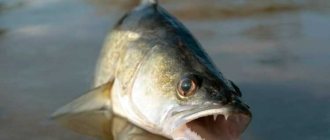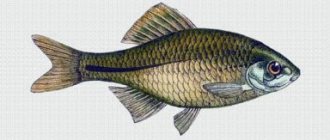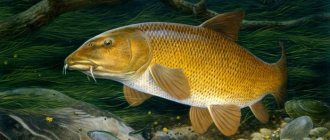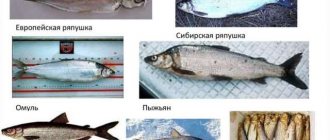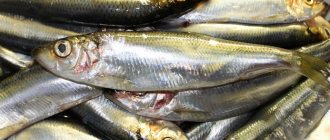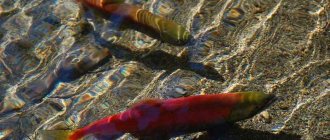Appearance
Has a flattened body. The head is relatively small, the nose is blunt. Large eyes of silver color. The color of the scales often varies depending on the habitat and seasons. Description of the typical color of the silver bream fish: the body is mainly silver, towards the back it turns into a bluish-gray tint, the fins are gray or red.
The usual length of this fish is 18-20 cm, and its weight is about 250 grams. There were also individuals with distinctive sizes. The most famous length of such a silver bream is 50 cm, and its weight is 1.2 kg.
White bream fish photo and description
The silver bream fish, photo and description, which you will find below, is quite widespread throughout Russia and far beyond its borders. The white bream itself, with its body shape, is very similar to a young bream, or rather, a bream, but has a smaller number of rays in the dorsal (3 simple and 8 branched) and anal (3 simple and 20-24 branched) fins, in addition, its scales are noticeable larger, and the paired fins are reddish in color.
The body of the silver bream is strongly flattened and its height is at least a third of its entire length, its nose is blunt, its eyes are large, silvery, its back is bluish-gray, the sides of its body are bluish-silver, the unpaired fins are gray, and the paired fins are red or reddish at the base, towards the apex dark gray. In addition, the silver bream, unlike the bream, has larger scales, especially at the dorsal fin, and also on the back, behind the back of the head, it has a groove not covered with scales.
However, this fish can change with increasing age, as well as depending on the time of year and local living conditions. The silver bream never reaches a significant size and for the most part it is no more than 450-500 g and less than 30 cm in length; less commonly, individuals weighing 700-800 g are found and only in a few places, for example in the Gulf of Finland. In Lake Ladoga it sometimes reaches a weight of up to one and a half kilograms.
Differences from other fish
In appearance, silver bream is often confused with bream. However, upon proper inspection, small distinctive details can be noticed. What is the difference between silver bream and bream?
The scales of the bream are smaller and more numerous.
Under suitable conditions of the reservoir, in which both species of fish happily live, the pectoral and dorsal fins have different colors: in young bream they are dark, acquiring a black edge along the edges, in white bream they are reddish.
The silver bream has 3 regular and 8 branched rays in the dorsal fin. As for the anal fin, there are 3 straight and 24 branched rays. Bream differs in that in both the first and second cases it has more rays.
The tail of the silver bream has a rounded notch and equal lateral parts. The tail section of the bream is different: the existing notch almost forms a right angle, and the side branches have different sizes.
It should also be noted that there are differences in the head section: that in the photo there are white breams, that when caught, the fish has larger eyes, set close to the tip of the muzzle. An individual of another species has smaller eyes and more distant from the nose.
An important and sometimes determining fact of the difference between the above-mentioned individuals is the number and arrangement of pharyngeal teeth: seven, and not five, as in others, pieces of teeth from each row. It is worth agreeing that it is more difficult to consider this detail among other points.
White bream has a less thick protective layer of mucus than young bream.
Features and habitat
The silver bream fish is very common in freshwater bodies, and many people confuse it with bream. The silver bream has been seen in many European reservoirs. There it is usually small, and only near Finland and in the Gulf of Ladoga do these fish reach quite large sizes. Gustera was seen in the Gulf of Finland near St. Petersburg.
The Black and Caspian seas are also places where the silver bream fish lives. It is often spotted in rivers near the White Sea; the Northern Dvina is especially rich in these fish. Many people are interested in what the silver bream looks like . It has certain differences from the bream, in particular, it has three simple rays in the upper fin, and also three rays in the anal fin, and in addition, twenty branched ones.
A beautiful fish with silver eyes, slightly flattened on the sides, its fins are usually gray, red at the base. There are many varieties of silver bream, the appearance of which depends on the habitat, age and nutrition. When winter comes, the silver bream sinks to the bottom. And there she gathers in flocks. With the onset of spring, she returns to her former habitats.
Habitats and food
This fish leads a schooling lifestyle. She is lazy, lethargic, willingly loves to be in the same area, rarely swimming away. Often adjacent to schools of bream. For her, it is preferable to have a quiet water surface, where it is warmer, where there is a slow current, as well as a clay or sandy bottom.
Adult silver bream fish swim to the bottom, while small fish prefer to be close to the shore, surrounded by sparse vegetation.
Gustera can be seen in almost all European countries. In Russia, it sticks mostly to the northwest, and is found in the Black Sea, Caspian and Baltic Seas.
It feeds on mud and small mollusks found in it, as well as crustaceans, worms (especially bloodworms), maggots, and does not hesitate to eat the eggs of other fish.
When
The silver bream spawns from the end of April to May at a water temperature of 12-20°. During prolonged cold spells, spawning may last until June. As a spawning site, the fish chooses shallow bays with dense vegetation, and it spawns very noisily. This happens in the late evening and at night. At dawn the spawning stops. The white bream spawns in portions; however, there are females that spawn at once.
Before spawning, they become bright silver, the pectoral and pelvic fins acquire an orange tint. In a spawning herd, males mature earlier than females. The silver bream becomes sexually mature at two or three years of age. Pearly bumps appear on the head and upper body of spawning males. Soon after spawning, all mating changes disappear. In older age groups of the spawning stock, there are significantly more females than males.
The silver bream grows slowly. One-year-olds have an average body length of 3.3 cm, three-year-olds - 10.2, and six-year-olds - 16.9 cm. Before puberty, both sexes grow equally, but after puberty, the growth of males slows down somewhat. After spawning, the silver bream begins to eat, and it is well caught.
Spawning and lifestyle
Sexual maturity in fish is reached at the age of 3-4 years, and such maturation in males occurs 1.5-2 years earlier. The spawning period occurs at the end of April, May and even the beginning of June (spawning of bream ends around the same time), when the water temperature reaches 12-16 degrees.
At this time, the color of the fish changes somewhat: the paired fins acquire a rich red color. Moreover, changes in a particular case affect males - grain-like tubercles grow along the edges of their scales, which disappear without a trace at the end of spawning.
The eggs are spawned in shallow bays and grassy quiet rivers. The smaller the fish, the earlier spawning begins, and vice versa. Small fish spawn up to 15 thousand eggs, while large fish can spawn about 100 thousand eggs in several portions.
Throwing begins in the morning and at night. The eggs are sticky, sinking, often lie under water near plants, and can die when the water level changes, because deposited at shallow depths.
The development of eggs lasts about a week. The younger generation increases in length slowly, about 3 centimeters per year.
Spawning period
The silver bream spawns from the end of April to May at a water temperature of 12-20°. During prolonged cold spells, spawning may last until June. As a spawning site, the fish chooses shallow bays with dense vegetation, and it spawns very noisily. This happens in the late evening and at night. At dawn the spawning stops. The white bream spawns in portions; however, there are females that spawn at once.
Before spawning, they become bright silver, the pectoral and pelvic fins acquire an orange tint. In a spawning herd, males mature earlier than females. The silver bream becomes sexually mature at two or three years of age. Pearly bumps appear on the head and upper body of spawning males. Soon after spawning, all mating changes disappear. In older age groups of the spawning stock, there are significantly more females than males.
The silver bream grows slowly. One-year-olds have an average body length of 3.3 cm, three-year-olds - 10.2, and six-year-olds - 16.9 cm. Before puberty, both sexes grow equally, but after puberty, the growth of males slows down somewhat. After spawning, the silver bream begins to eat, and it is well caught.
Fishing Features
You shouldn’t really rely on catching large specimens - you can rarely find fish weighing more than 400 grams. If the weather is warm, it can be easier to catch in the summer at night or early in the morning.
When it gets colder, it swims into deep holes. It loves a relief bottom, so immediately before fishing it is worth taking into account the characteristics of the soil under water and the nature of changes in the depth of the earth.
The main catch occurs in the spring using a seine, but in the fall they can also be found in large numbers in the lower reaches of rivers. The places where rivers flow into the lake, enriched in food and oxygen, attract silver bream; this should be taken into account when choosing a fishing spot.
Fishing methods
White bream biting is observed throughout the year - perhaps with the exception of the spawning period. You can catch it both from the ice in winter and in open water in the warm season. During the zhora period, silver bream can be caught at any time of the day, but it is best in the evening, morning and on moonlit nights. In early June, the silver bream begins to eat intensely. In mid-summer it weakens and intensifies again by the beginning of autumn.
The bite stops only with the onset of inclement weather.
The most common gear for catching silver bream is a float rod. For fishing in open water - both still and in the current - depending on the conditions, the following can be used:
- fly rods;
- Bolognese rods;
- match rods;
- plug rods.
Bottom fishing is also practiced in open water using feeders, pickers and other bottom gear.
Among other things, silver bream is successfully caught with side rods from a boat.
To catch silver bream from the ice in winter, fishermen use float rods and various jigs.
Serious fishing is never complete without bait. White bream also responds well to early attachment to the fishing site, which is done 3-4 days before fishing. You can buy bait in the store and prepare it yourself. For this purpose, mainly plant food is used: porridge, cakes, bran, steamed cereal grains. Animal ingredients are also possible: such as maggots, worms, shellfish. Gustera also responds well to flavorings (anise, hemp oil, etc.). The main thing when choosing the composition of bait is to take into account local conditions and the usual type of food to which the fish are accustomed.
The bait is thrown into the fishing area immediately before fishing. The ideal bait is a mixture that contains a lot of fragrant, finely crushed components. The solid components of the bait (cake, crackers, bran) should be finely dispersed, literally ground into dust.
They “smoke” in the water, but when the fish approaches, it will not be able to eat.
Bait is an equally important element in catching silver bream. The fisherman should have several types of baits in stock, since the silver bream is a picky fish. The following are the most common baits:
- maggot;
- bloodworm;
- worms;
- flour products (bread, pasta, dough);
- cereals and porridges (rolled oats, pearl barley, semolina, peas).
You can also catch a silver bream using a goose (dragonfly larva), a caddis fly, a small herbivorous leech, and a zebra mussel. The preferences of the fish depend on many factors, so it is better to experiment with baits.
Gustera does not have valuable gastronomic qualities. Its meat is lean, fresh and contains a lot of small bones. Therefore, the main method of preparing silver bream is drying. It is dried in the same way as other small white fish.
Where else can you get a good catch?
- near sunken objects;
- at bridge supports;
- along the edges from vegetation;
- in mouths and pits.
Fishing after spawning and in winter
It is worth considering that fish can be caught after spawning, at a depth of about one and a half meters, but at the very peak of this period it is not even worth trying - it will not bite.
What does a caught silver bream look like? Having spawned in early June, it quickly begins to get fat and is already of greater interest, as it becomes more tasty, and therefore attractive prey.
If the catch begins not in the daytime, but at dawn or late at night, it is better to bite the silver bream on a float rod or donkey. If fishing takes place in coastal shallow areas, then a feeder is best.
In winter, silver bream, unlike bream, is less capricious and resourceful, and therefore can successfully replace other small fish at the time of catch. It is unpretentious to the thickness of the fishing line and changes in weather.
By storing worms from the autumn season, you can safely make holes when the first ice appears and throw bait there from time to time. The latter, being bait, will increase appetite and make it habitual for fish to be found at these holes, which can be used for catching large specimens.
Fishing for silver bream
Gustera loves not only large lowland rivers, but also often lives in small rivers. This is a schooling fish, and is found in the same places where bream lives. Ideal fishing spots are where calm water meets the current.
We recommend: Is it possible to swim and fish on the Vityazevsky Estuary
They do not like places with fast flowing water, as their body is not designed to swim in such places.
In the lake, you should look for it in quiet bays with a sandy or muddy bottom and protected from the wind. They can be found near coastal thickets and water lilies. Often accompanied by species such as roach, bream and rudd.
You can catch silver bream starting in early spring; the best results occur from July to September; good bite occurs in late autumn.
It practically does not feed during spawning, usually from April to the end of May and possibly in the first half of June; at this time it is useless to catch.
A good bite begins immediately after spawning.
Fishing can be done almost around the clock, but it is most active at dawn and dusk.
Main lures:
Maggot, pearl barley, worms and other baits that are suitable for bream.
Groundbait:
All baits are suitable for bream, roach and carp.
Fishing methods:
Float rod, feeder and donka. The gear is the same as for medium-sized bream up to half a kilogram. The methods and fishing are similar to bream fishing.
Share link:

